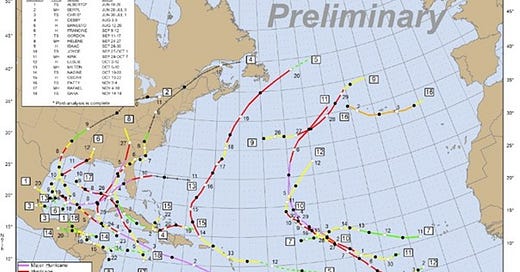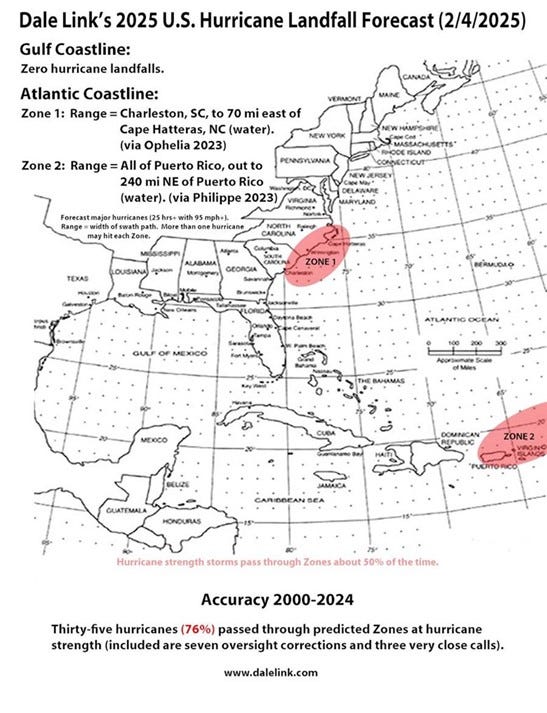Energy Musings - March 13, 2025
Winter is fading. Spring is arriving. We have survived the Daylight Savings Time change. Now it is time to focus on hurricane season. Here are the earliest predictions for the upcoming season.
Less Than 90 Days To Hurricane Season
“In the Spring a young man’s fancy lightly turns to thoughts of love,” wrote Alfred Lord Tennyson in his poem Locksley Hall. That may be true for young men. However, after overcoming the daylight savings time change, most people, especially those on the U.S. Gulf and East Coasts, turn to the upcoming hurricane threat.
The earliest looks at the upcoming season have arrived. Traditionally, the first forecasts arrive at the start of April, but now we are getting early forecasts in February. Forecasters feel good about their ability to predict tropical storm activity after turning in their best year in forecast accuracy last year.
One of the leading storm forecasters is the Tropical Weather and Climate Research Team at Colorado State University. It produces an annual verification report that measures how well each of its four forecasts – April, June, July, and August – performed. Last year, its April and June forecasts were the most accurate, correctly predicting the observed number of hurricanes (11) and major hurricanes (5). They noted that during the season, 18 named storms formed, less than the 23 named storms they predicted in April, June, and August and well below the 25 named storms predicted in July.
The National Hurricane Center (NHC), part of the National Weather Service division of the National Oceanic and Atmospheric Administration (NOAA), also tracks its forecast accuracy. While the final report will be released later this spring, the preliminary report shows that 2024’s forecasts were the agency’s most accurate year. The NHC produced 347 forecasts for tropical cyclones in the Atlantic basin last year, above the 1990-2023 annual average of 325 forecasts. The higher number was due to last year being a very active season.
NHC’s map of 2024 storms and hurricanes confirms an active year.
The NHC review tracks many of its forecast variables. It reported that every forecast interval (12, 24, 36, 48, 60, 72, 96, and 120 hours) broke records for accuracy. The chart shows how trends in forecasting accuracy improved during 1990-2024, although there is substantial variation in accuracy from year to year.
NHC hurricane forecasts continue to improve their accuracy.
It is appropriate for forecasters to demonstrate how much their tools and models continue to improve. Better forecasts mean fewer lives being lost and less storm damage because people can better prepare with more timely and accurate predictions. That is a huge positive. But what about the future?
WeatherBELL Analytics LLC, a New York-based firm helping businesses manage their weather risk, produced its initial 2025 hurricane forecast in late February. It wrote that its forecast looks at weather metrics – MJO patterns, warm sea surface temperatures (SST), and a weak or possibly neutral El Niño by the start of hurricane season – similar to 2018. Therefore, they see a less active season than in 2024 but still above average because of quick, weak storms and development close to the coast. WeatherBELL’s forecast sees 15-19 named storms, 7-9 hurricanes, 2-3 major hurricanes, and an accumulated cyclone energy (ACE) of 120-150.
The Houston Chronicle wrote about the upcoming hurricane season. It contacted Phillip Klotzbach, head of the Colorado State University tropical storm forecasting unit. He had written on X recently that the current European Centre for Medium-Range Weather Forecasts modeling “calls for a near-average Atlantic hurricane season through [September]." That means around 12 named storms and five hurricanes.
WeatherBELL’s storm forecast last year was well above normal and even above the active seasonal forecasts. Therefore, their forecast for this year may be too aggressive, especially after the ECMRW forecast.
Anthony Yanez, Chief Meteorologist for Houston television station KPRC, made the final observation about the upcoming hurricane season. He followed the tradition of the station’s former Chief Meteorologist, Frank Billingsley, who would show the forecast from Dale Link. He is not a meteorologist. Instead, he’s an engineer with a system for identifying where the storms will likely make landfall.
The founder of Colorado State University’s Tropical Meteorological Project in 1984, Dr. William Gray, focused on climate change and landfall forecasting when he retired from the unit in 2005. That focus helped secure financial backing from insurance companies, which realized the importance of preparation for tropical storm landfalls to reduce damages.
Good news for Houston in the upcoming hurricane season.
Link’s forecast shows no impact for Houston this year and a respite for the entire Gulf Coast with no landfalls predicted. This could also be good news for the domestic oil and gas industry. It could also benefit the economy with fewer weather and storm damage disruptions.
The primary storm landfall target areas are the Carolinas and Puerto Rico. These two zones have historically been among the most active regions for storm landfalls.
There are several more weeks before Colorado State University and NHC release their initial detailed 2025 hurricane season forecasts. This year will not be like last year or the year before. That is good news for coastal residents.






